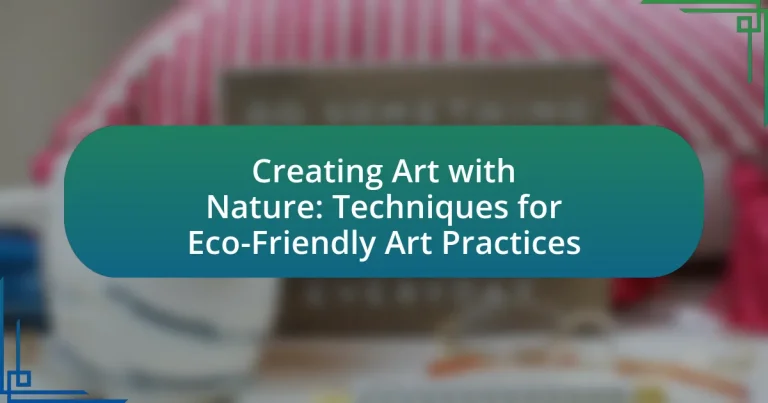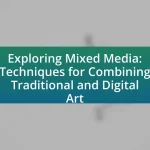Eco-friendly art practices prioritize sustainability and environmental responsibility by utilizing natural, non-toxic materials and techniques that minimize ecological impact. This article explores the differences between eco-friendly and traditional art methods, highlighting the use of organic paints, recycled materials, and biodegradable substances. It discusses the benefits of creating art with nature, including fostering environmental awareness and enhancing mental well-being, while also outlining practical techniques for sourcing materials sustainably. Additionally, the article addresses the challenges artists face in adopting eco-friendly practices and offers strategies for overcoming these limitations, ultimately promoting a culture of sustainability within the art community.
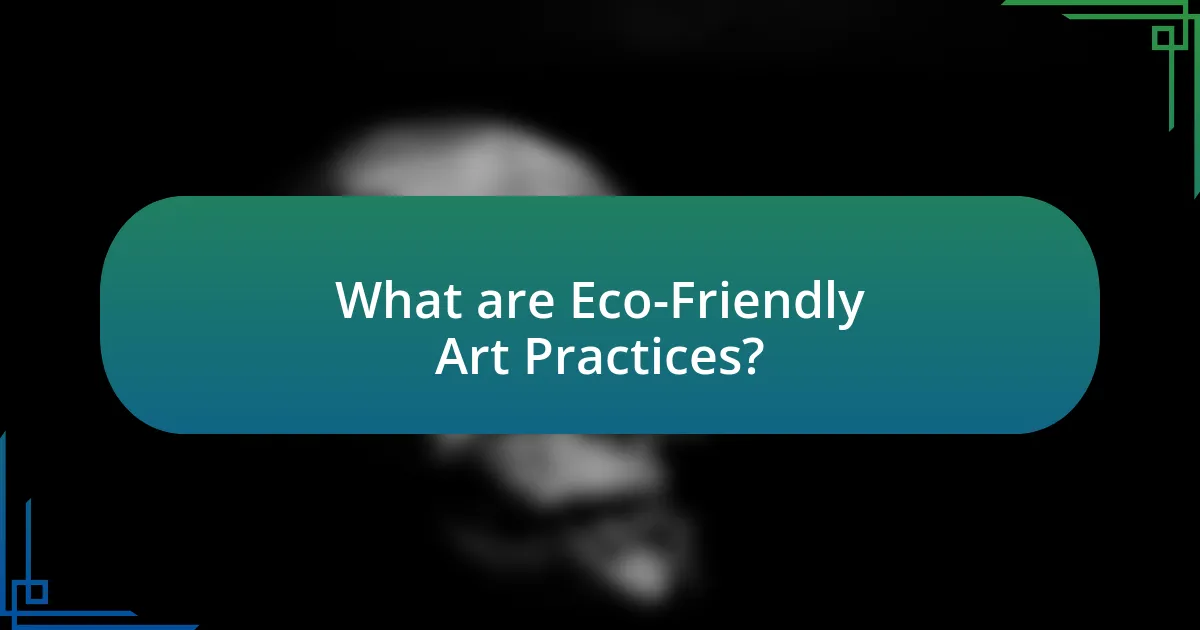
What are Eco-Friendly Art Practices?
Eco-friendly art practices are artistic methods that prioritize sustainability and environmental responsibility. These practices often involve using natural, non-toxic materials, such as plant-based pigments, recycled or upcycled materials, and biodegradable substances. For instance, artists may create works using organic materials like clay, wood, or natural fibers, which minimize environmental impact. Additionally, eco-friendly art practices can include techniques like land art, where artists use natural landscapes to create temporary installations, thereby promoting awareness of ecological issues. The adoption of these practices is supported by the growing movement towards sustainability in the art world, reflecting a commitment to reducing waste and conserving resources.
How do eco-friendly art practices differ from traditional art methods?
Eco-friendly art practices differ from traditional art methods primarily in their use of sustainable materials and environmentally conscious techniques. While traditional art often relies on synthetic paints, plastics, and non-biodegradable materials, eco-friendly art emphasizes natural, recycled, or non-toxic substances, such as plant-based dyes and biodegradable mediums. This shift not only reduces environmental impact but also promotes a connection to nature, as seen in practices like land art and the use of organic materials. For instance, artists like Andy Goldsworthy utilize natural elements to create temporary installations that highlight the beauty of the environment, contrasting with traditional methods that may contribute to pollution and waste.
What materials are considered eco-friendly in art creation?
Eco-friendly materials in art creation include organic paints, recycled paper, natural fibers, and biodegradable glues. Organic paints are made from natural pigments and binders, reducing harmful chemicals in the environment. Recycled paper minimizes waste and promotes sustainability by reusing materials. Natural fibers, such as cotton and hemp, are renewable resources that have a lower environmental impact compared to synthetic options. Biodegradable glues, often derived from plant sources, break down naturally, further supporting eco-friendly practices in art.
Why is sustainability important in art practices?
Sustainability is important in art practices because it minimizes environmental impact and promotes responsible resource use. Artists adopting sustainable methods can reduce waste, utilize eco-friendly materials, and engage in practices that support ecological balance. For instance, the use of non-toxic paints and recycled materials not only lessens pollution but also encourages a circular economy within the art community. Furthermore, studies indicate that sustainable art practices can raise awareness about environmental issues, fostering a culture of sustainability among audiences and inspiring collective action towards ecological preservation.
What are the benefits of creating art with nature?
Creating art with nature fosters environmental awareness and promotes mental well-being. Engaging with natural materials encourages individuals to appreciate their surroundings, leading to a deeper understanding of ecological systems. Studies indicate that spending time in nature can reduce stress and anxiety, enhancing overall mental health. For instance, research published in the journal “Environmental Science & Technology” found that exposure to natural environments significantly improves mood and cognitive function. Additionally, using sustainable materials in art reduces waste and promotes eco-friendly practices, contributing to environmental conservation efforts.
How does nature inspire creativity in artists?
Nature inspires creativity in artists by providing a rich source of visual and sensory experiences that stimulate imagination and innovation. The diverse colors, forms, and textures found in natural environments often serve as direct references for artistic expression, influencing styles and techniques. For instance, the Impressionist movement, led by artists like Claude Monet, was heavily inspired by the changing light and landscapes of nature, leading to a new approach to color and brushwork. Additionally, studies have shown that exposure to natural settings can enhance cognitive function and emotional well-being, further fostering creative thinking. Research published in the Journal of Environmental Psychology indicates that spending time in nature can improve problem-solving skills and increase the likelihood of creative breakthroughs.
What impact does eco-friendly art have on the environment?
Eco-friendly art positively impacts the environment by reducing waste and promoting sustainability. This type of art often utilizes recycled materials, which minimizes landfill contributions and conserves natural resources. For instance, a study published in the Journal of Environmental Management highlights that using reclaimed materials in art can significantly decrease the carbon footprint associated with production processes. Additionally, eco-friendly art raises awareness about environmental issues, encouraging communities to engage in conservation efforts and adopt sustainable practices.
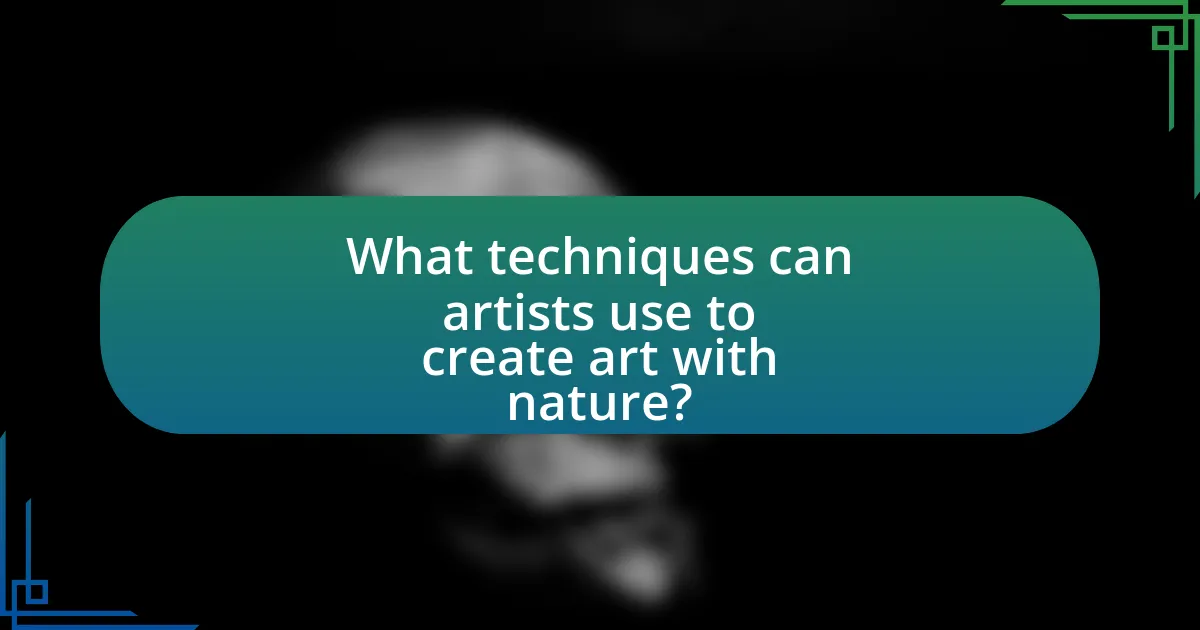
What techniques can artists use to create art with nature?
Artists can use techniques such as natural materials, land art, and eco-printing to create art with nature. Utilizing natural materials involves sourcing items like leaves, stones, and wood to construct artworks, which emphasizes sustainability and connection to the environment. Land art, exemplified by works from artists like Robert Smithson, involves altering the landscape itself to create large-scale installations that blend with the natural surroundings. Eco-printing, a technique where artists use plant materials to create prints on fabric or paper, showcases the colors and textures of nature, promoting awareness of ecological processes. These methods not only foster creativity but also encourage a deeper appreciation for the natural world.
How can natural materials be sourced for art projects?
Natural materials for art projects can be sourced through local environments, community gardens, and sustainable suppliers. Artists can collect items such as leaves, twigs, stones, and flowers from parks or natural reserves, ensuring they follow local regulations regarding foraging. Additionally, collaborating with local farmers or gardeners can provide access to organic materials like fruits and vegetables, which can be used in various art forms. Research indicates that using locally sourced materials not only reduces environmental impact but also fosters a deeper connection to the community and nature, enhancing the artistic process.
What are some examples of natural materials used in eco-friendly art?
Natural materials used in eco-friendly art include clay, wood, leaves, stones, and natural fibers. Clay is often utilized for pottery and sculptures due to its malleability and abundance. Wood serves as a versatile medium for carving and construction, while leaves can be used for printmaking or as natural pigments. Stones provide a durable option for sculptures and installations, and natural fibers like cotton, jute, and hemp are commonly employed in textiles and weaving. These materials are favored for their sustainability and minimal environmental impact, aligning with eco-friendly art practices.
How can artists ensure they are sourcing materials sustainably?
Artists can ensure they are sourcing materials sustainably by selecting eco-friendly, renewable, and recycled materials for their work. This approach includes using organic pigments, sustainably harvested wood, and recycled paper, which minimizes environmental impact. For instance, the use of certified sustainable wood, such as that from the Forest Stewardship Council, guarantees that the materials come from responsibly managed forests. Additionally, artists can research suppliers who prioritize sustainability and transparency in their sourcing practices, ensuring that their materials do not contribute to deforestation or pollution. By adopting these practices, artists can create art that aligns with eco-friendly principles while supporting a sustainable economy.
What methods can be employed to create art using natural elements?
Methods to create art using natural elements include land art, eco-printing, and using natural pigments. Land art involves arranging natural materials like stones, leaves, and soil in outdoor settings to create large-scale installations, as exemplified by artists like Robert Smithson. Eco-printing utilizes plant materials to transfer colors and shapes onto fabric or paper, a technique documented in the book “Eco-Printing: Creative Fabric Dyeing with Leaves, Flowers & More” by India Flint. Additionally, natural pigments derived from minerals, plants, and other organic materials can be used in painting, providing a sustainable alternative to synthetic colors. These methods emphasize the use of environmentally friendly materials and promote a connection to nature.
How can artists incorporate plant life into their artwork?
Artists can incorporate plant life into their artwork by using actual plant materials, such as leaves, flowers, and stems, as mediums or subjects in their pieces. This method allows for the creation of natural textures and colors that are often difficult to replicate with traditional art supplies. For instance, artists can create pressed flower art, botanical illustrations, or even sculptures made from twigs and branches. Additionally, techniques like eco-printing, where plant pigments are transferred onto fabric or paper, further integrate plant life into the artistic process. This approach not only enhances the visual appeal of the artwork but also promotes sustainability by utilizing natural materials.
What techniques are effective for using earth pigments in art?
Effective techniques for using earth pigments in art include dry application, wet mixing, and layering. Dry application involves using powdered pigments directly on surfaces, allowing for texture and depth. Wet mixing combines pigments with a binder, such as gum arabic or acrylic medium, to create paint, which enhances color vibrancy and adhesion. Layering involves applying multiple transparent or semi-transparent washes of pigment to build depth and complexity in the artwork. Historical practices, such as those used by ancient cultures, demonstrate the durability and richness of earth pigments, validating their effectiveness in various artistic applications.
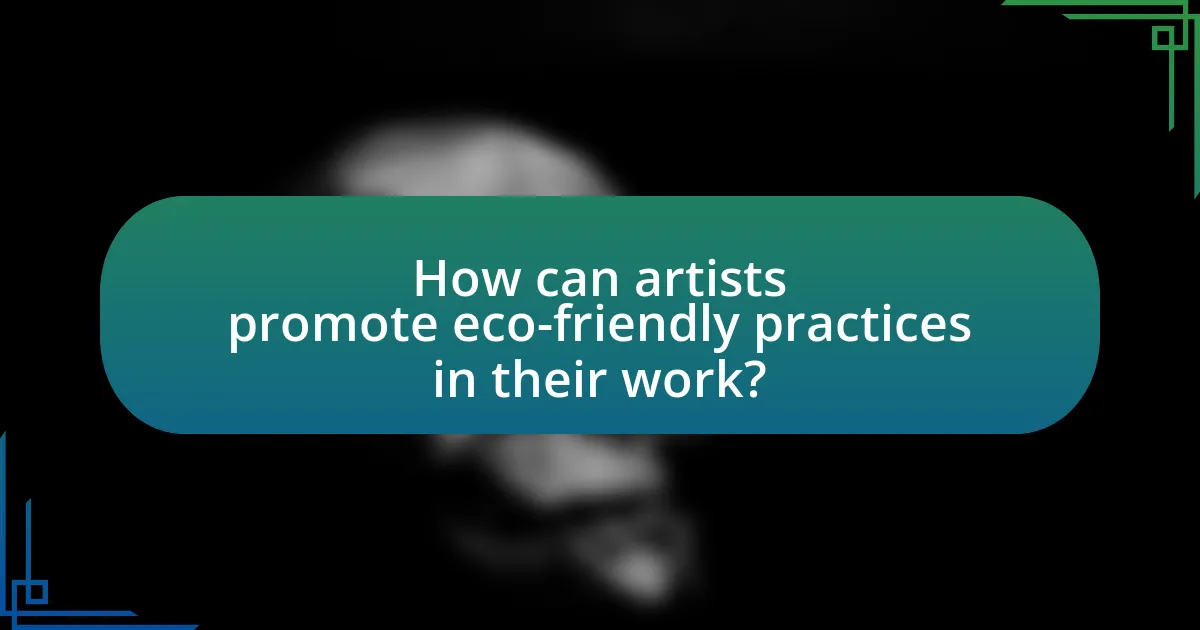
How can artists promote eco-friendly practices in their work?
Artists can promote eco-friendly practices in their work by utilizing sustainable materials and techniques. For instance, they can choose non-toxic paints, recycled paper, and biodegradable materials, which reduce environmental impact. Additionally, artists can incorporate natural elements into their art, such as using plant-based dyes or found objects, which not only minimizes waste but also emphasizes the connection to nature. Research indicates that the use of sustainable materials in art can significantly lower carbon footprints, as demonstrated in studies by the University of California, which found that eco-friendly art practices can reduce waste by up to 50%. By adopting these methods, artists not only create environmentally conscious works but also inspire their audiences to consider sustainability in their own lives.
What role does education play in eco-friendly art practices?
Education plays a crucial role in eco-friendly art practices by equipping artists with the knowledge and skills necessary to create sustainable works. Through educational programs, artists learn about environmentally responsible materials, techniques, and the impact of their art on ecosystems. For instance, courses on sustainable art practices often cover the use of recycled materials and non-toxic pigments, which directly contribute to reducing environmental harm. Research indicates that artists who receive training in sustainability are more likely to incorporate eco-friendly methods into their work, thereby promoting a culture of environmental awareness within the art community.
How can artists share their eco-friendly techniques with others?
Artists can share their eco-friendly techniques with others through workshops, online tutorials, and social media platforms. Workshops allow artists to engage directly with participants, demonstrating sustainable practices in real-time. Online tutorials, such as videos or blog posts, provide accessible resources for a wider audience, enabling artists to showcase their methods and materials. Social media platforms facilitate the sharing of images, videos, and tips, creating a community around eco-friendly art practices. For instance, platforms like Instagram and YouTube have become popular for artists to reach global audiences, promoting sustainable techniques effectively.
What are some community initiatives that support eco-friendly art?
Community initiatives that support eco-friendly art include programs like the “EcoArt Project,” which promotes sustainable art practices by connecting artists with environmental organizations to create works that raise awareness about ecological issues. Additionally, “Art for the Earth” is an initiative that organizes workshops and exhibitions focused on using recycled materials and natural resources in art, fostering community engagement and education on sustainability. These initiatives demonstrate a commitment to integrating environmental consciousness into artistic expression, encouraging both artists and the public to participate in eco-friendly practices.
What are some common challenges faced in eco-friendly art practices?
Common challenges faced in eco-friendly art practices include limited access to sustainable materials, higher costs associated with eco-friendly supplies, and the difficulty of achieving desired artistic effects without traditional materials. Artists often struggle to find high-quality, environmentally friendly alternatives to conventional paints, canvases, and other mediums, which can hinder their creative expression. Additionally, the financial investment required for sustainable materials can be prohibitive, especially for emerging artists. Research indicates that artists may also face a lack of awareness or education about eco-friendly practices, making it challenging to implement sustainable techniques effectively.
How can artists overcome the limitations of using natural materials?
Artists can overcome the limitations of using natural materials by employing innovative techniques and alternative methods. For instance, they can combine natural materials with synthetic ones to enhance durability and versatility, allowing for greater creative expression. Additionally, artists can explore various preservation methods, such as using natural resins or oils, to extend the lifespan of their works. Research indicates that integrating technology, such as digital tools for design and planning, can also help artists visualize and execute their ideas more effectively while still honoring the essence of natural materials.
What strategies can be implemented to address environmental concerns in art?
Strategies to address environmental concerns in art include using sustainable materials, promoting eco-conscious themes, and engaging in community-based projects. Sustainable materials, such as recycled paper, natural pigments, and biodegradable substances, reduce waste and environmental impact. Artists can also focus on eco-conscious themes that raise awareness about environmental issues, encouraging viewers to reflect on their relationship with nature. Additionally, community-based projects, like collaborative murals or installations using local resources, foster environmental stewardship and connect art with local ecosystems. These strategies not only minimize ecological footprints but also inspire collective action towards sustainability in the art community.
What are practical tips for starting eco-friendly art projects?
To start eco-friendly art projects, use sustainable materials such as recycled paper, natural pigments, and biodegradable glues. These materials reduce environmental impact and promote sustainability. For instance, using recycled paper can save trees and reduce waste, while natural pigments derived from plants or minerals minimize chemical usage. Additionally, consider sourcing local materials to decrease transportation emissions and support local economies. Engaging in community art projects can also foster collaboration and awareness about eco-friendly practices.
How can beginners choose the right materials for eco-friendly art?
Beginners can choose the right materials for eco-friendly art by selecting non-toxic, sustainable, and biodegradable options. Non-toxic paints, such as those made from natural pigments or plant-based ingredients, minimize environmental impact and health risks. Sustainable materials like recycled paper, reclaimed wood, and organic fabrics reduce waste and promote resource conservation. Biodegradable items, including natural glues and plant-based inks, ensure that the art will not contribute to landfill issues. Research indicates that using eco-friendly materials can significantly lower the carbon footprint of art practices, making it essential for environmentally conscious artists to prioritize these options.
What are some simple eco-friendly art projects to try at home?
Some simple eco-friendly art projects to try at home include creating leaf prints, making recycled paper, and crafting natural dyes. Leaf prints can be made by collecting leaves, applying paint, and pressing them onto paper, which showcases the intricate patterns of nature. Making recycled paper involves blending used paper with water, straining it, and allowing it to dry, thus reducing waste and promoting sustainability. Crafting natural dyes can be achieved by using kitchen scraps like onion skins or beet peels to color fabrics, providing a creative way to repurpose food waste. These projects not only foster creativity but also emphasize environmental consciousness.
